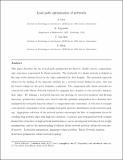Load-path optimisation of funicular networks
Author(s)
Liew, A.; Van Mele, T.; Block, P.; Pagonakis, Dimitrios
Download11012_2017_714_ReferencePDF.pdf (8.809Mb)
PUBLISHER_POLICY
Publisher Policy
Article is made available in accordance with the publisher's policy and may be subject to US copyright law. Please refer to the publisher's site for terms of use.
Terms of use
Metadata
Show full item recordAbstract
This paper describes the use of load-path optimisation for discrete, doubly curved, compression-only structures, represented by thrust networks. The load-path of a thrust network is defined as the sum of the internal forces in the edges multiplied by their lengths. The presented approach allows for the finding of the funicular solution for a network layout defined in plan, that has the lowest volume for the given boundary conditions. The compression-only thrust networks are constructed with Thrust Network Analysis by assigning force densities to the network’s independent edges. By defining a load-path function and deriving its associated gradient and Hessian functions, optimisation routines were used to find the optimum independent force densities that minimised the load-path function subject to compression-only constraints. A selection of example cases showed a dependence of the optimum load-path and force distribution on the network topology. Appropriate selection of the network pattern encouraged the flow of compression forces by avoiding long network edges with high force densities. A general, non-orthogonal network example showed that structures of high network indeterminacy can be investigated both directly for weight minimisation, and for the understanding of efficient thrust network patterns within the structure. Keywords: Load-path optimisation, Minimum volume problem, Thrust Network Analysis, Structural optimisation, Thrust network topology
Date issued
2017-06Department
Massachusetts Institute of Technology. Department of MathematicsJournal
Meccanica
Publisher
Springer Netherlands
Citation
Liew, A., et al. “Load-Path Optimisation of Funicular Networks.” Meccanica, vol. 53, no. 1–2, Jan. 2018, pp. 279–94.
Version: Author's final manuscript
ISSN
0025-6455
1572-9648